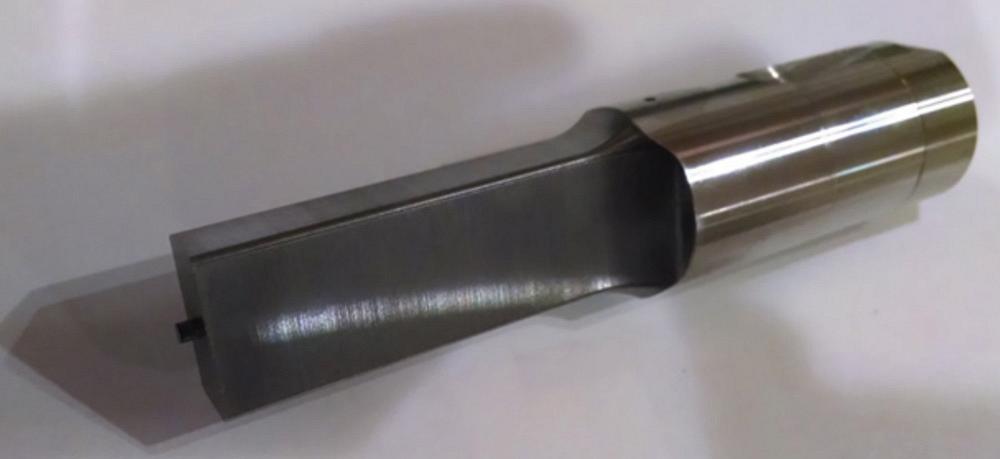Contributing Writer
- FMA
- The Fabricator
- FABTECH
- Canadian Metalworking
Categories
- Additive Manufacturing
- Aluminum Welding
- Arc Welding
- Assembly and Joining
- Automation and Robotics
- Bending and Forming
- Consumables
- Cutting and Weld Prep
- Electric Vehicles
- En Español
- Finishing
- Hydroforming
- Laser Cutting
- Laser Welding
- Machining
- Manufacturing Software
- Materials Handling
- Metals/Materials
- Oxyfuel Cutting
- Plasma Cutting
- Power Tools
- Punching and Other Holemaking
- Roll Forming
- Safety
- Sawing
- Shearing
- Shop Management
- Testing and Measuring
- Tube and Pipe Fabrication
- Tube and Pipe Production
- Waterjet Cutting
Industry Directory
Webcasts
Podcasts
FAB 40
Advertise
Subscribe
Account Login
Search
Die Science: Slug pulling—Causes and solutions
- By Art Hedrick
- June 11, 2015
- Article
- Bending and Forming
Slug pulling in a stamping die can be costly and frustrating. One pulled slug can cripple production.
What Is Slug Pulling?
When a pierce punch creates a hole, it also produces scrap, called the slug. When the slug sticks to the face of the punch during withdrawal or comes out of the button or lower matrix, it is called slug pulling.
Slug pulling can be a serious problem in a stamping operation. If a slug falls off the punch and onto the strip or part, it can damage parts and the die. Keeping the slug down in the matrix or, better yet, pushing it out of the die completely is the desired scenario.
What Are the Typical Causes of Slug Pulling?
Numerous factors contribute to slug pulling: trapped air, large cutting clearances, extremely fast piercing, sticky lubricants, improperly demagnetized punches, and fatigued or insufficient spring ejectors.
Trapped Air/ Vacuum Pockets. Slugs generated during piercing have a certain amount of curvature. Air is trapped in that void area of the slug, creating a vacuum (see Figure 1a).
Keep in mind that the metal you are cutting behaves like an elastomer. During the piercing process, a tight seal is created around the punch perimeter. During withdrawal, this seal prevents the slug from coming off the punch. The use of heavy lubricants only increases the sealing action.
The only portion of the piercing punch that makes contact with the metal is a localized zone around the outside diameter. Even punches with angularity or shear angles ground on them make only localized contact with the metal (see Figure 1b). To reduce the amount of vacuum being created, make a small air vent in the center of the pierce punch, through which the otherwise trapped air can escape. Reducing the suction this way will break the seal between the slug and the punch and allow the slug to fall off the pierce punch. This might not solve all your slug pulling issues, but it certainly will help.
If your pierce punches are too small to vent, you will need to address slug pulling with other methods. Using a vacuum unit under the button is a common solution to pull the slugs off the face of the piercing punches. Equipment made expressly for this purpose is available, but a good wet/dry vacuum also will work.
Large Cutting Clearances. Although using large cutting clearances can result in much longer punch and matrix life, the tendency for slug pulling increases with the size of the cutting clearance.
When smaller cutting clearances are used in the perforating process, both the slug and metal outside the slug are forced into compression. After the slug is cut free, it decompresses and remains in the matrix because the slug now has an interference or press fit into the matrix.

Figure 1
During piercing, air is trapped in the void
area of the slug, creating a vacuum (a) (left). This
causes the punch to have only localized
contact with the metal (b) (right).
With larger cutting clearances, the slug is slightly smaller than the hole in the matrix, and the slug may be pulled freely from the matrix with the punch. Reducing the cutting clearance can help solve this problem, but it also will reduce the life of the punch and increase the necessary sharpening frequency. So rather than reducing the cutting clearance, try pushing the slugs off the punch or holding them tight in the button or matrix using a spring-loaded ejector (see Figure 2).
If the punch is too small to use a spring ejector, try using a slug-retention button that holds the slug in the matrix using compression. This button comprises two small slots machined at an angle in each side of the matrix. These slots generate a burr on the slug, and the burr is forced downward at an angle and wedged into the matrix. Another style has barbs in the matrix that impale themselves into the slug to keep it in place.
A reverse-taper bell-mouth button is another option. Most die buttons have a bell-mouth taper machined into them, with the hole diameter increasing toward the bottom of the button. In the reverse-taper button, the hole in the matrix gets slightly smaller as it nears the clearance opening. This holds the slugs in compression in the matrix. Keep in mind that for most piercing operations, 0.0005 to 0.001 inch is more than enough taper; if the taper is too great, compression can cause the matrix to split.
Magnetism Problems. When punches and die sections are sharpened, they often are placed and ground using a surface grinder. Most surface grinders hold the sections and punches by securing them to a high-power magnet. Any ferrous metal that comes in contact with this magnet becomes slightly magnetized.
Magnetized pierce punches and die sections can cause slug pulling and can attract other magnetic debris, carrying it through the tool. So be sure to demagnetize all die components after grinding. Commercial units are available for this task.
Prevent Disaster
The consequences of a pulled slug can be disastrous and should not be taken lightly. A single slug being carried through a progressive die can cause damage to every station in the tool.
The process of addressing slug pulling problems begins with an understanding of why the slugs are pulling in the first place.
About the Author

Art Hedrick
10855 Simpson Drive West Private
Greenville, MI 48838
616-894-6855
Related Companies
subscribe now

The Fabricator is North America's leading magazine for the metal forming and fabricating industry. The magazine delivers the news, technical articles, and case histories that enable fabricators to do their jobs more efficiently. The Fabricator has served the industry since 1970.
start your free subscription- Stay connected from anywhere

Easily access valuable industry resources now with full access to the digital edition of The Fabricator.

Easily access valuable industry resources now with full access to the digital edition of The Welder.

Easily access valuable industry resources now with full access to the digital edition of The Tube and Pipe Journal.
- Podcasting
- Podcast:
- The Fabricator Podcast
- Published:
- 04/16/2024
- Running Time:
- 63:29
In this episode of The Fabricator Podcast, Caleb Chamberlain, co-founder and CEO of OSH Cut, discusses his company’s...
- Trending Articles
How to set a press brake backgauge manually

Capturing, recording equipment inspection data for FMEA

Tips for creating sheet metal tubes with perforations

Are two heads better than one in fiber laser cutting?

Hypertherm Associates implements Rapyuta Robotics AMRs in warehouse

- Industry Events
16th Annual Safety Conference
- April 30 - May 1, 2024
- Elgin,
Pipe and Tube Conference
- May 21 - 22, 2024
- Omaha, NE
World-Class Roll Forming Workshop
- June 5 - 6, 2024
- Louisville, KY
Advanced Laser Application Workshop
- June 25 - 27, 2024
- Novi, MI




























